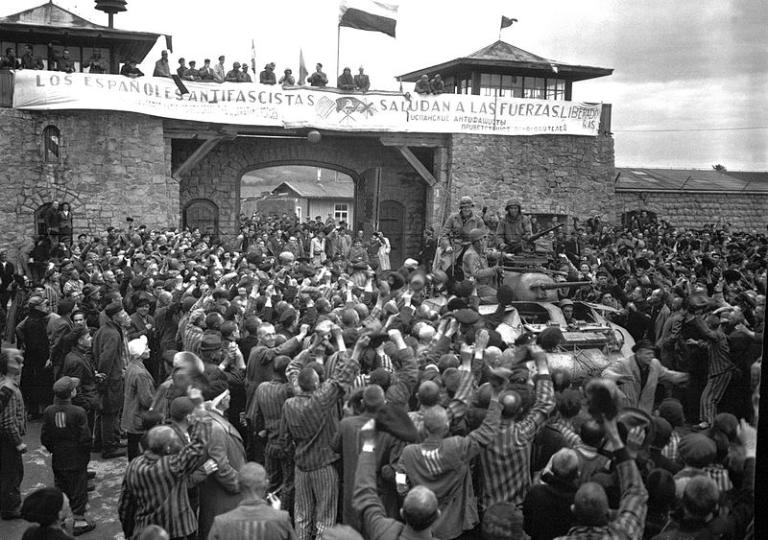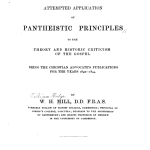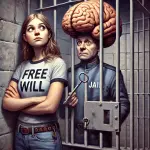
(Photo from Wikimedia Commons public domain)
Back in July 2018, I wrote a newspaper column devoted to the question “Was Adolf Hitler religious?” My answer to that question was that he was not religious. Certainly not in any common understanding of the term, whether Christian or simply theistic. I’ve sometimes been challenged on my answer, but I stand by it.
One of the titles that I bought at the book shop at KZ-Dachau a couple of days ago is Hitler: Die 101 wichtigsten Fragen (Munich: Verlag C. H. Beck, 2019). It was written by Volker Ullrich, who has also written several other books on German history, including a two-volume study of Adolf Hitler (2013, 2018). Here, in my translation, is a relevant extract from Hitler: Die 101 wichtigsten Fragen:
Hitler grew up in a Catholic milieu. He practiced as a choirboy at the Benedictine cloister in Lambach. . . . His confirmation took place on Pentecost 1904 in the Cathedral of Linz. However, according to his later account, the fifteen-year-old submitted to this ceremony only reluctantly. Nevertheless, over the course of his life Hitler never formally exited the Church. But he was surely never a believing Christian. If Hitler believed in anything, it was, above all, in himself, in his mission, which was supposedly assigned to him by “providence.”
Accordingly, National Socialism was framed as a political religion, and the Führer presented himself as the Messiah sent by the “Almighty” who would redeem the German people from all evils. The sacralizing of his person expressed the exaltation of the Party to the status of a “community of faith” and of the Party program to a “confession of faith.” In his speeches, especially in his concluding “apotheoses,” Hitler liked to resort to a religious vocabulary — for instance, when he ended his rally in the Sportpalast on 10 February 1933 with the cry of “Amen!” . . .
After 30 January 1933 [when he was appointed chancellor of Germany], Hitler first took the stage in the robe of a Christian statesman who intended to bring about a national rebirth in concert with the Christian confessions. It remained his long-term goal, of course, to subject the churches to absolute ideological claims of National Socialism. Nonetheless, Hitler knew that he could not attain this goal through brute force if he didn’t want to alienate large portions of the population. Therefore, he followed a double strategy — on the one hand to come to a modus vivendi with the Catholic and Protestant church and, on the other, to engage dissenting priests and pastors with repressive measures. The decisive confrontation with the churches was to be delayed until after the successful conclusion of the war. (101-103)
Today, we visited the Upper Austrian city of Linz, where we walked around a bit both before and after we had lunch. (We visited the former cathedral, for example, where Anton Bruckner was the organist and choir master and where, as noted above, Adolf Hitler was confirmed.) Thereafter, we spent a couple of hours at the former Nazi concentration camp of Mauthausen, which is not very far from Linz. I’ve brought this up here several times before: This is at least my fourth visit to Mauthausen, in fulfillment of a sense of obligation to my father, who, as a member of the 11th Armored Division of Patton’s Third Army, participated in the liberation of the camp and was forever marked by it. He charged me to always remember his testimony about Mauthausen, and to keep the memory of it alive.
One of his assignments, as the war was effectively over by the time Mauthausen was liberated (the last of the camps to be taken by the Allies) — Hitler had committed suicide about a week before Mauthausen’s liberation — was to document in photos the appalling and unbelievable things that he and his fellow soldiers had encountered upon entering the place. Thereafter, he created a display of some of his photographs in the main square of Linz, directly in front of the City Hall, titling his display “Nazi Kultur.” For decades thereafter, he remembered Austrians walking by, looking at the images, shaking their heads, and saying “Das habe ich nie gewusst! Das habe ich nie gewusst!” (“I didn’t know that! I didn’t know that!”) He didn’t altogether believe them.
Today, once again, I walked through KZ-Mauthausen. And today, yet again, I stood in front of what is now called the “Old City Hall,” exactly where my father’s photographic display of “Nazi Kultur” stood just slightly more than seventy-seven years ago.
I note that I’m being accused by the usual small handful of people of ignoring the Mountain Meadows Massacre while I’m posting about Nazi concentration camps and, I guess, of suggesting that religious people in general, or Latter-day Saints in particular, do not commit evil deeds. Or something like that.
But I haven’t ignored the Mountain Meadows Massacre. Here, for example, is a blog entry that I posted here back in 2019:
And let me append two basic observations:
1) When I write anything for the public, at least some entirely predictable people will misread it in the most negative way that they possibly can.
2) The Mountain Meadows Massacre is, for quite manifest reasons, a controversial topic. And, accordingly, it’s one that some people are strongly inclined to exploit for ideological ends.
The perpetrators of the Massacre interest me very particularly because, overwhelmingly, they do not seem to have been conventionally bad people — thugs, murderers, and the like — either before September 1857 or, for the most part, thereafter. So the question that puzzles me (in this case as in more than a few others) is, What makes ordinary, decent people commit so extraordinarily horrific a crime? Which is precisely the topic that I raised in yesterday’s post about KZ-Dachau.
Reading the Oxford book Massacre at Mountain Meadows, by Ron Walker and Rick Turley and Glen Leonard, when it first came out many years ago, I felt as if I were seeing a Greek tragedy unfold. There was a certain inexorable logic to what ultimately happened — a horrible logic, obviously, but one in which it made a certain degree of sense, after one bad step had been taken, to take the next one. I found myself wanting to scream “No! Stop!” while knowing what the outcome was inevitably going to be.
To me, if we see the people who committed the Mountain Meadows Massacre as utterly unlike ourselves, we’re not only falsifying history (and not merely in the sense that they, like me and many of my readers, claimed membership in the Church of Jesus Christ of Latter-day Saints) but refusing to see a lesson (or, more aptly, lessons) in what happened. If they were something of a different species, their cautionary tale can have little if anything to teach us. Precisely the same thing can be said about the Nazi concentration camps: If we think that only Germans and Austrians are capable of such things, we’re both demonstrably wrong and utterly missing the most important principles to be learned. As Aleksandr Solzhenitsyn wisely said,
The line separating good and evil passes not through states, nor between classes, nor between political parties either — but right through every human heart.
In order to understand what the perpetrators of the Mountain Meadows Massacre did, we need to understand what factors acted upon them. And, beyond any reasonable dispute, one of the most important of those factors was a prior history of persecution and forced migration. But that doesn’t mean that the Missouri mobs bear legal and moral responsibility for the Mountain Meadows Massacre any more than an abusive father is responsible for the violent acts committed much later by a criminal son. However, neither are the two completely unrelated. Human evils ramify. They do damage, among other things to human psyches.
The Mountain Meadows Massacre certainly isn’t the Restoration’s finest hour. It’s anything but faith-promoting. But it shouldn’t be exploited as a weapon against the Church or against religious belief, either. It’s too complex to be reducible to a self-serving slogan on a partisan bumper sticker.
Posted from Ruhpolding, Upper Bavaria, Germany










